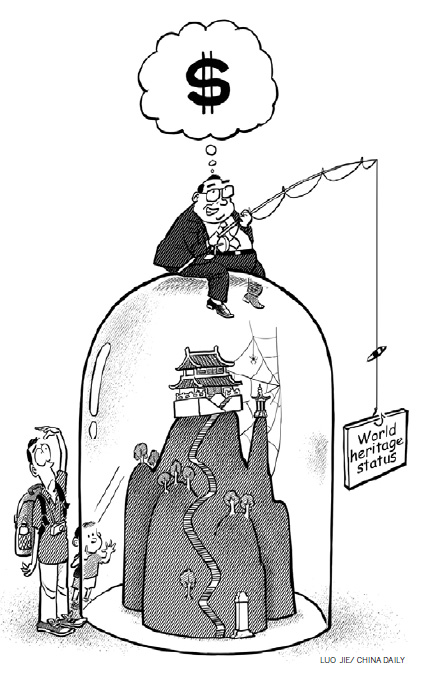Op-Ed Contributors
Debate: Heritage sites in China
(China Daily)
Updated: 2010-09-06 07:59
 |
Large Medium Small |
Quip Fang
Good effort in the wrong direction
The Danxia Landform recently became China's 40th world heritage site, leading to an upsurge in other places bidding for the UNESCO honor. About 35 Chinese sites, including the West Lake in Hangzhou, are trying to get the world heritage stamp from UNESCO.
The "heritage fever" seems to be born out of some local governments' passion for culture. But in total contrast to their apparent love for culture, some local governments have demolished (or are in the process of demolishing) numerous heritage sites. The "demolition fever" is stronger, because it has the backing of some local governments and property developers, and brings in ready money. Call it the power of GDP growth, if you will.
But the mad rush of some local governments to get sites in their areas the world heritage tag is driven by GDP growth, too. Many of them have spent tens of millions, if not hundreds of millions, of yuan for the purpose. For example, Xinning county of Hunan province has spent more than 400 million yuan to "package" Mount Langshan, one of the six Danxia Landform areas. Many would be surprised to know that the fiscal revenue of the county is only about 200 million yuan, and to win the bid, it secured a bank loan of 155 million yuan.
Such generous spending certainly entails greater returns. For instance, the heritage tag has boosted the tourism industry of the ancient city of Pingyao in Shanxi province. The local tourism industry's income, which accounted for barely 1 percent of the local GDP, increased by almost 13 times a year after it got the UNESCO stamp. That has boosted the local GDP growth too, just like the realty business is doing elsewhere.
The heritage stamp on sites, whether cultural or natural, is just to increase the incomes of local governments and the tourism industry. Most of the income from ticket sales goes into governments' coffers, and the money tour groups earn goes to pay their officials and other staff and to expand their business. What is left for maintenance of the sites is less than one-tenth of the income.
Focused on rapid economic growth, governments at all levels are exploiting the environment, and cultural and natural heritage sites. Then there are heritage sites that are very old, such as the Hanging Monastery in Shanxi, which could collapse under the heavy footsteps of tourists. Sadly, officials seem unconcerned about the long-term survival of such sites. The story of many a heritage site is one of shortsightedness, not different from the one about the goose that laid the golden egg.
Such commercialization of heritage sites - natural or cultural, national or regional - can have negative effects. Many of the sites are no longer the realm of the people but dominated by the local governments. Worse, the public has lost its right to walk into natural scenic spots free of charge.
Natural heritage sites are nature's gifts, and our ancestors passed down the cultural and historical ones to us. They are and always have been public property and should be accessible to us all, free. Our ancestors, especially literary figures, roamed the country freely in search of inspiration. They walked into forests and gardens, climbed mountains and ventured into deserts and rivers and lakes. They marveled at new places, appreciated the architecture and mixed with people to leave us the incredible legacy of their literary works. A heritage site is the bond that connects the past with the present, ancient with the modern.
But today most of those sites are walled, wired and reduced to scenic spots that can be seen only after paying an entrance fee. They have thus been alienated from the people. This is a disservice to the country's culture. The bidding for world heritage status should be aimed at preserving the sites, and not to only lure in the lucre. Once such sites are included in the list and framework of local economic development, they are bound to become the private property of the local governments.
Suppose some officials decide to take over a religious site and develop it for commercial use.
What will the followers of that religion do? Pay for praying there? Such absurd privatization is against the human spirit. Local governments defend their actions by citing the massive amounts of money they spend to get the heritage tag for a site. What they fail to understand is, despite all their efforts a heritage site remains public property. The money that governments' spend on the so-called upkeep of the sites is their share of responsibility for preserving our heritage and promoting our culture. Therefore, the heritage sites that local governments have walled up should be open to the public for free. Every citizen has the right to demand that, because such sites are the legacy of the people and the country.
The author is a research scholar with the Jiuding Public Affairs Research Institute, a civil think tank.
